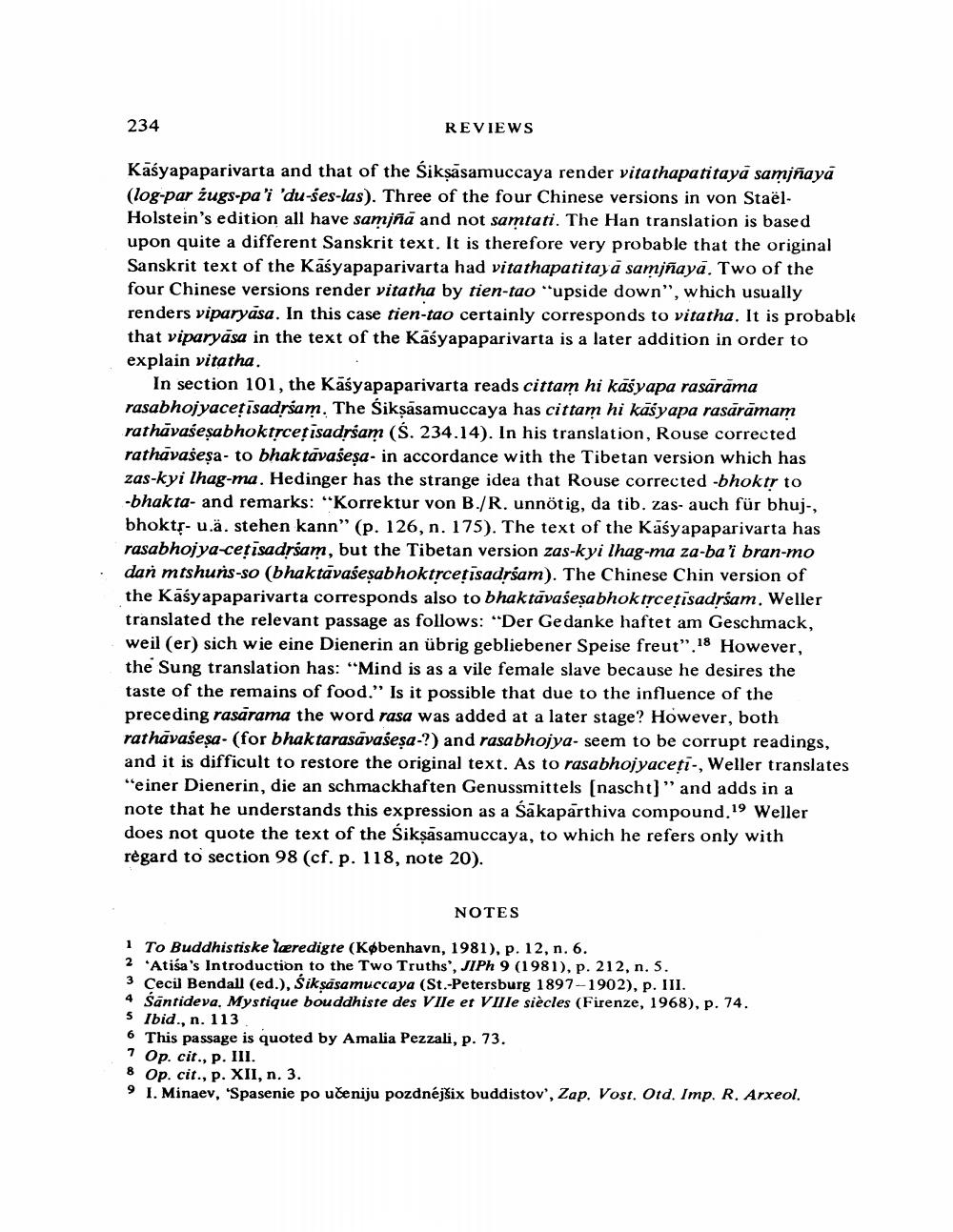________________
234
REVIEWS
Kaśyapaparivarta and that of the Siksasamuccaya render vitathapatitaya samiñaya (log-par zugs-pa'i 'du-ses-las). Three of the four Chinese versions in von StaëlHolstein's edition all have samjñā and not samtati. The Han translation is based upon quite a different Sanskrit text. It is therefore very probable that the original Sanskrit text of the Kaśyapaparivarta had vitathapatitaya samjñaya. Two of the four Chinese versions render vitatha by tien-tao upside down", which usually renders viparyāsa. In this case tien-tao certainly corresponds to vitatha. It is probable that viparyāsa in the text of the Kasyapaparivarta is a later addition in order to explain vitatha.
In section 101, the Kaśyapaparivarta reads cittam hi kasyapa rasārama rasabhojyacețisadssam. The Sikşasamuccaya has cittam hi kasyapa rasārāmam rathāvašesabhoktycețisadrsam (S. 234.14). In his translation, Rouse corrected rathāvašeșa- to bhak tavaseșa- in accordance with the Tibetan version which has zas-kyi lhag-ma. Hedinger has the strange idea that Rouse corrected -bhoktr to -bhakta- and remarks: “Korrektur von B./R. unnötig, da tib. zas- auch für bhuj, bhoktr- u.ä. stehen kann" (p. 126, n. 175). The text of the Kaśyapaparivarta has rasabhojya-cețisadrsam, but the Tibetan version zas-kyi lhag-ma za-ba'i bran-mo dan mtshuns-so (bhaktāvašeşabhoktrcetisadrśam). The Chinese Chin version of the Kaśyapaparivarta corresponds also to bhaktavaseșabhoktycețisadrśam. Weller translated the relevant passage as follows: "Der Gedanke haftet am Geschmack, weil(er) sich wie eine Dienerin an übrig gebliebener Speise freut". 18 However, the Sung translation has: "Mind is as a vile female slave because he desires the taste of the remains of food." Is it possible that due to the influence of the preceding rasarama the word rasa was added at a later stage? However, both rathāvašeşa- (for bhaktarasāvašeșa-?) and rasabhojya- seem to be corrupt readings, and it is difficult to restore the original text. As to rasabhojyaceti., Weller translates "einer Dienerin, die an schmackhaften Genussmittels (nascht]" and adds in a note that he understands this expression as a sakapārthiva compound.19 Weller does not quote the text of the Sikşasamuccaya, to which he refers only with regard to section 98 (cf. p. 118, note 20).
NOTES
1 To Buddhistiske læredigte (København, 1981), p. 12, n. 6. 2 Atiśa's Introduction to the Two Truths', JIPh 9 (1981), p. 212, n. S. 3 Cecil Bendall (ed.), Śik sasamuccaya (St.-Petersburg 1897-1902), p. III. 4 Santideva, Mystique bouddhiste des Vlle et VIIIe siècles (Firenze, 1968), p. 74. 5 Ibid., n. 113
This passage is quoted by Amalia Pezzali, p. 73. 7 Op. cit., p. III. 8 Op. cit., p. XII, n. 3. 9 I. Minaev, 'Spasenie po učeniju pozdnéjšix buddistov, Zap. Vost. Otd. Imp. R. Arxeol.




